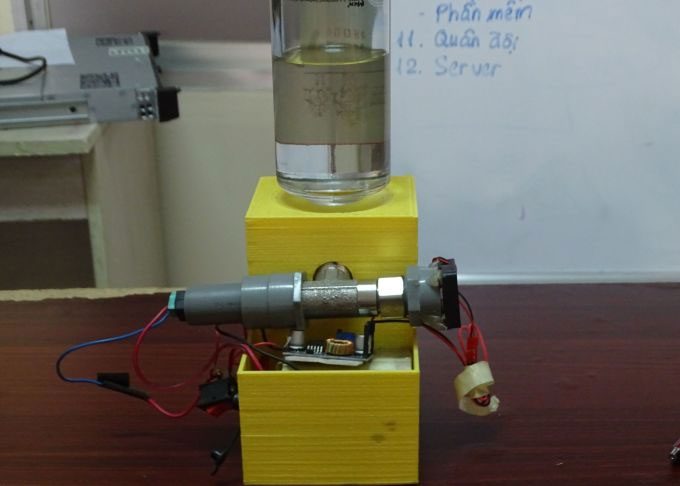A group of students from Ho Chi Minh City International University has developed a methanol concentration detection device (a component that causes poisoning in alcoholic beverages) with an accuracy rate of over 98%.
The research was conducted by Nguyễn Ngọc Huy (majoring in Automation) and Trần Phúc Khang (majoring in Electronics) since 2020, aiming to create a new solution for determining methanol concentration in alcoholic beverages.
Previously, detecting methanol concentration in alcoholic beverages required laboratory chemical analysis techniques, which were time-consuming and costly. The device created by Huy’s team uses near-infrared light to read methanol components. The product is designed to be portable, consisting of a 24V halogen lamp to generate light. Opposite the lamp is an integrated spectrometer camera along with a control circuit.
When a bottle of alcohol is placed in the testing area, the spectrometer camera captures images and analyzes the wavelength changes of the color. The captured data is displayed on a graph to produce results indicating the methanol content in the beverage.
Over the course of more than a year, the team tested over 300 samples of methanol-contaminated alcohol at various concentrations, with the contaminated alcohol showing impurities at wavelengths from 700 to 1070 nm. The results indicated that the product’s accuracy rate exceeded 98%. “This is an initial success that can demonstrate the technology’s ability to determine methanol concentration in alcohol,” Huy stated. The team is finalizing procedures to publish their research in an international journal.

The methanol concentration detection device created by the team. (Photo: Hà An).
Sharing the motivation behind the research, Huy explained that methanol and ethanol have similar chemical and physical properties, but methanol is much simpler and cheaper to produce than ethanol. Currently, many businesses aim to increase profits by adding methanol to alcoholic beverages. Numerous cases of alcohol poisoning, which can be fatal, occur due to excessive methanol consumption. According to medical literature, methanol concentrations starting from 20 mg/dL can cause poisoning, concentrations above 50 mg/dL require emergency dialysis, and levels over 80 mg/dL carry a risk of death. However, Huy noted that it is very difficult to identify methanol in alcohol because it is nearly undetectable by sight, smell, or taste.
“Alcoholic beverages often contain many complex substances, including volatile components… so to determine methanol content, chemical analysis samples must be taken,” Huy commented. With this product, the team hopes to provide the public with a quick and visual tool for assessing methanol concentration. Before consuming alcohol, users only need to place the bottle in the spectrometer. After a few seconds, the system analyzes and transmits data to a mobile application (which the team is currently developing) to help buyers identify the methanol concentration in the alcohol. The estimated price for one device is around 2 million VND.

Graph showing methanol levels in alcohol at different concentrations. (Photo: NVCC)
Dr. Nguyễn Đình Uyên, a lecturer at the Faculty of Electronics and Telecommunications, Ho Chi Minh City International University, assessed that this research direction is highly applicable, and the team has built a database for determining methanol concentration to provide scientific evaluations.
According to him, near-infrared spectroscopy technology utilizes a spectrum of light that is invisible to the naked eye. This technology can also be applied to identify chemicals present in meat, preservatives in fruits, and more, quickly.
He believes that, in addition to determining methanol concentration, the team needs to develop a database for various types of alcohol so that the product can be more widely applicable. This will help identify the proportions of components present in the alcohol, allowing users to know if the beverage contains impurities.
However, Dr. Uyên also acknowledged that building an evaluation database is a crucial step in distinguishing the quality of alcohol. “I will support the team in working with businesses that recognize the potential of this research direction to expedite the commercialization of the product,” Dr. Uyên stated.


















































